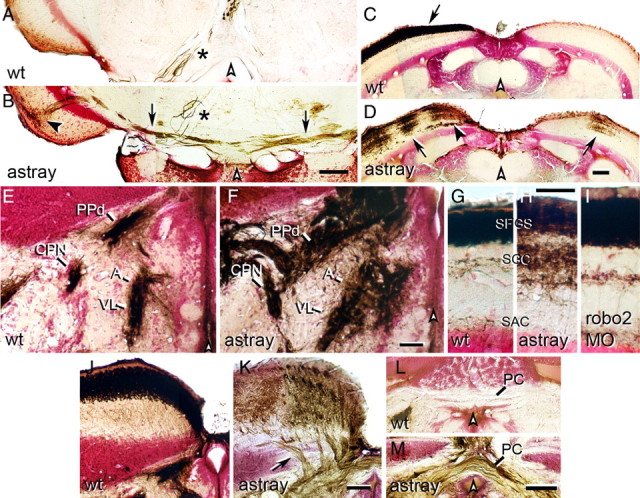Figure 2.

Aberrations of the optic projection in adult astray mutants and robo2 morphants. Photomicrographs show optic axons (brown) in cross sections of the adult brain (counterstained in red); dorsal is up. White arrowheads indicate brain midline. A, B, Ectopic optic tracts (B, arrows) in the tegmentum of astray mutants cross the midline and terminate in the ipsilateral tectum (black arrowhead). No ectopic tracts are present in wild-type animals (A). Asterisks (A, B) indicate large diameter axons of the oculomotor nucleus that are always inadvertently retrogradely traced from the eye muscles. C, D, In wild-type fish (C), optic axons cover the entire contralateral tectum only (arrow in C). In astray mutants (D) the contralateral and ipsilateral tectal halves are innervated in ocular dominance column-like patches (D, arrows). Note deep axons growing into the tectum in astray mutants (black arrowhead in D). E, F, Innervation of the CPN, the anterior (A) and ventrolateral thalamus (VL), as well as the dorsal part of the periventricular pretectal nucleus (PPd) is expanded in astray (F) compared with wild-type (E). G–I, Innervation of tectal layers is expanded in astray mutants (H), but not in robo2 morpholino-treated animals (I) compared with wild-type (G). SFGS, Stratum fibrosum et griseum superficiale; SGC, stratum griseum centrale; SAC, stratum album centrale. J, K, In astray mutants (K), but not in wild-type animals (J), optic axons enter the tectum in several individual deep fascicles (arrow in K). L, M, Optic axons cross in the posterior commissure (PC) in astray (M), but not in wild-type fish (L). Scale bars: A, B, E–I, 50 μm; C, D, J–M, 100 μm.
